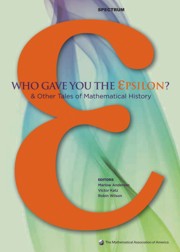Book contents
- Frontmatter
- Introduction
- Contents
- Analysis
- Geometry, Topology and Foundations
- Algebra and Number Theory
- Foreword
- Hamilton's Discovery of Quaternions
- Hamilton, Rodrigues, and the Quaternion Scandal
- Building an International Reputation: The Case of J. J. Sylvester (1814–1897)
- The Foundation Period in the History of Group Theory
- The Evolution of Group Theory: A Brief Survey
- The Search for Finite Simple Groups
- Genius and Biographers: The Fictionalization of Evariste Galois
- Hermann Grassmann and the Creation of Linear Algebra
- The Roots of Commutative Algebra in Algebraic Number Theory
- Eisenstein's Misunderstood Geometric Proof of the Quadratic Reciprocity Theorem
- Waring's Problem
- A History of the Prime Number Theorem
- A Hundred Years of Prime Numbers
- The Indian Mathematician Ramanujan
- Emmy Noether
- “ Marvelous Proof,”
- Afterword
- Surveys
- Index
- About the Editors
Afterword
from Algebra and Number Theory
- Frontmatter
- Introduction
- Contents
- Analysis
- Geometry, Topology and Foundations
- Algebra and Number Theory
- Foreword
- Hamilton's Discovery of Quaternions
- Hamilton, Rodrigues, and the Quaternion Scandal
- Building an International Reputation: The Case of J. J. Sylvester (1814–1897)
- The Foundation Period in the History of Group Theory
- The Evolution of Group Theory: A Brief Survey
- The Search for Finite Simple Groups
- Genius and Biographers: The Fictionalization of Evariste Galois
- Hermann Grassmann and the Creation of Linear Algebra
- The Roots of Commutative Algebra in Algebraic Number Theory
- Eisenstein's Misunderstood Geometric Proof of the Quadratic Reciprocity Theorem
- Waring's Problem
- A History of the Prime Number Theorem
- A Hundred Years of Prime Numbers
- The Indian Mathematician Ramanujan
- Emmy Noether
- “ Marvelous Proof,”
- Afterword
- Surveys
- Index
- About the Editors
Summary
In chapter 10 of his A History of Algebra [26], B. L. van der Waerden repeats much of what he wrote about Hamilton's discovery of quaternions. Interestingly, there he mentions Caspar Wessel as one of the originators of the geometric interpretation of complex numbers, while in the current article he ignores Wessel. But he also goes on to discuss Cayley's own use of quaternions to describe rotations in three-space, meanwhile pointing out the earlier results of Rodrigues. In addition, he deals with some applications of quaternions to the question of representing integers as sums of four squares. He concludes by discussing Hermann Hankel's 1867 book that presents many of Grassmann's results, but in a form that was easier to understand.
Simon Altmann writes in his article that we know “next to nothing” about Olinde Rodrigues, but in the next fifteen years he remedied this situation, publishing the results in his recent biography, Mathematics and Social Utopias in France: Olinde Rodrigues and His Times [1]. Similarly, Karen Parshall went on to do further research on the life and work of Sylvester. Her results appear in her edition of Sylvester's letters [18] as well as in her magnificent biography of the English mathematician [19].
Israel Kleiner has expanded his paper on group theory and some of his other work on the history of algebra into a new book, A History of Abstract Algebra [15]. Leo Corry's Modern Algebra and the Rise of Mathematical Structures [5] is another recent work that concentrates specifically on the development of abstraction in the nineteenth and twentieth centuries, but claims that true abstraction did not come into being until the work of Emmy Noether in the 1920s.
- Type
- Chapter
- Information
- Who Gave You the Epsilon?And Other Tales of Mathematical History, pp. 375 - 378Publisher: Mathematical Association of AmericaPrint publication year: 2009

